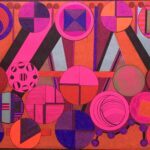This article is about creativity and courage, specifically artistic. There is also a unique socio-political history between these two countries. The focus of this article is on what psychologist Dr. Rollo May termed the “creative courage of artists.”
Art can impact people’s passion, attitudes, values, culture and politics. This is especially true when it is designed to do so. Though continents apart, with different languages and cultural histories, Mexico and Poland have both used art to impact social change. Governments played a major role in both countries to support visual art as a means of influencing social, economic and political objectives. The distinctively different art styles of these two countries shared common purposes.
Mexico’s world famous mural paintings from 1920 to 1970 contained strong social and political messages. Diego Rivera (1886-1957), Jose’ Clemente Orozco (1883-1949) and David Siqueiros (1896-1974) are the most influential muralists from the 20th century. They are “the three great ones,” (los tres grandes). The walls of massive public buildings served as their canvas to reach all the people, not just elite art admirers. Following periods of armed struggle, Mexico’s government established a mural program that wasn’t solely artistic. Able to reach much of the public, these murals presented ideals. Enlisting the great painters of the times captured the attention of the masses. The government made good on its promise of artistic freedom but the artists had many serious conflicts where their visualized opinions differed from that of the government. Such conflict assured that these works would be designed with great passion yet also risked the freedom and very lives of the artists. The expressive murals were produced on large plastered walls of monumental structures. The people were immersed within the large-scale paintings, their imagery, colors and historical messages.
Poland historically suffered many oppressive occupations and military struggles. As Germany’s defeat in WWII became clearer, the departing soldiers were ordered to destroy the principal city of Warsaw as well as any evidence of detention and death camps. The Polish people were then governed by the Russian victors and subjected to harsh Communist repressive regulations and laws. The newly imposed government strategically understood that a massive rebuilding of a city was necessary but also sought to introduce its own socialistic culture and arts to the people. The street would be the classrooms and galleries. The government wanted to present its view of “populist ideals” using the credibility of Poland’s leading artists who survived the ravages of war. Henryk Tomaszewski (1914-2005), Tadeusz Trepkowski (1914-1954), and Tadeusz Gronowski (1894-1990) were the “three great ones” that founded the later to be internationally recognized art style called the Polish School of Poster Design. With construction ongoing everywhere, the city was filled with available walls and fences. Mexico’s painted murals were on beautiful public buildings, Warsaw’s art medium for their working people had to be in the form of street posters. These were painterly designed visual art works on fragile paper to advertise events, deliver political messages and promote social values. As in Mexico, the artists founding this movement insisted on government’s concession to allow artistic freedom. The most effective posters would inspire viewers artistically while through recognizable embedded visual messages the posters would also project hope and national unity.
The “art of the streets” of both countries influenced attitudes and cultural movements. There exists a paradox in having government commission public art to further its control. But within the works of these six great artists their interpretation and independent view of reality impacted their people’s behavior and values. Decades later, with many millions of worldwide viewers of Mexico’s magnificent murals and museum exhibitions of Poland’s fine art posters, we are reminded that courage may take different forms.



